U.S. Department of Transportation
Federal Highway Administration
1200 New Jersey Avenue, SE
Washington, DC 20590
202-366-4000
Federal Highway Administration Research and Technology
Coordinating, Developing, and Delivering Highway Transportation Innovations
|
Research & Technology Transporter This newsletter is an archived publication and may contain dated technical, contact, and link information. |
|
| Publication Number: N/A Date: February 1996 |
Publication Date: February 1996
|
The Research & Technology Transporter was a Federal Highway Administration (FHWA) research and technology publication issued under FHWA's Research and Technology Program. The 8-page newsletter transmitted research and technology-based developments from FHWA program offices to engineers in the field and professionals in the industry. Publication of the Research & Technology Transporter ended with the September 2006 issue.
Last Updated: 6/10/96
| Federico F. Peña Secretary, U.S. Department of Transportation |
| Rodney E. Slater Administrator, Federal Highway Administration |
| Jane F. Garvey Deputy Administrator, Federal Highway Administration |
| RTCG CHAIRPERSONS |
|---|
| Bud Wright--Safety Stan Gordon--Structures Jim Scapellato--Motor Carriers Paul Teng--Pavements Gary Euler--ITS Bob Ford--International Barna Juhasz--Policy, Planning, Environment, Information Management & Right-of-Way |
| Anne Barsanti, Managing Editor Jon Schans, Editor Zac Ellis, Editor |
The U.S. Department of Transportation's Small Business Innovation Research Program solicited proposals to develop an inexpensive visibility sensor to be used on highways to warn drivers of restricted visibility. Dense fog, dust storms, smoke, heavy rain, and snow have been known to cause multi-vehicle accidents. Systems have been developed to warn drivers of these restricted conditions by using changeable message signs and roadside radio. The cost of the visibility sensors for these systems range from $2,000 to $12,000, thus limiting the number of sensors that can be afforded. If a good, reliable, low-cost sensor can be developed, the length of roadway that can be covered with these systems can be greatly expanded.
There are two phases to this project. Phase one sets out to determine the feasibility of developing and inexpensive, reliable visibility sensor for use on highway warning systems. Two contracts were let for conducting phase one of this research, the most promising of which is described below.
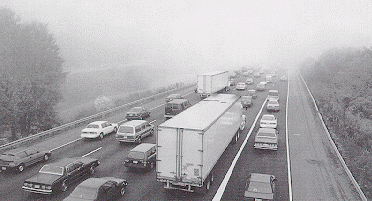
Results showed that the sensor has sufficient sensitivity, linearity, and measurement stability. The sensor is robust against environmental conditions. The cost for manufacturing is estimated to be about $300 per sensor, not including communications hardware. The installation and maintenance cost, which can be a major portion of the system's life-cycle costs, can be also significantly reduced compared to existing sensor units.
For phase two of the project, a 2-year contract has been awarded for further developing and testing the sensors. This will involve the design of engineering prototypes, laboratory testing the prototypes, field testing the prototypes, and analyzing the results.
The prototypes will be field tested in Georgia along with an automated visibility warning system on I-75 near Adel. Prototypes will also be installed in Michigan at a railroad-highway grade crossing and at fog sites. Consideration is being given for installing the prototypes in California or Arizona where possible dust storms are present.
- Howard Bissell,
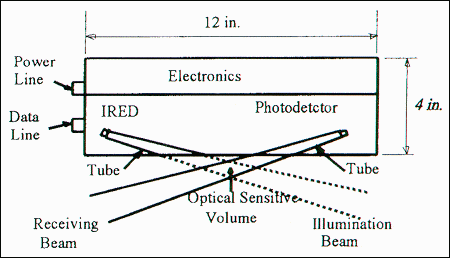
The sensor consists of an optical system, analog electronics, digital electronics, analog-digital converter, and provision for communication to the warning system.
During the late fall, three visitors from the Republic of South Korea met with Marcia Simon and Steve Forster of the Special Projects and Engineering Division at the Turner-Fairbank Highway Research Center (TFHRC). The visitors came to learn more about using recycled portland cement concrete as aggregate in new concrete and as base material under pavements. The visitors represented the Korea Institute of Construction Technology and a private construction firm in Korea.
The meeting began with an overview of U.S. engineering experience using recycled concrete as aggregate in new concrete pavement. As part of the overview, typical characteristics of the recycled material and properties of the recycled concrete were discussed. In addition, the results of staff research conducted at TFHRC on the properties of recycled concrete as aggregate and a status report on a current FHWA contract study investigating the performance of recycled concrete aggregate in concrete pavements were provided. The remainder of the meeting was spent discussing specific questions the visitors had. As a follow-up to the visit, additional references on the use of recycled concrete and pavement evaluation techniques and procedures were sent to the visitors.
- Marcia Simon, (202) 493-3071.
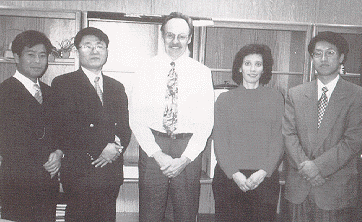
Korean visitors Weon-Cheal Park, Sean Hyun Lee, and Kyu Woong Bae flank Steve Forster and Marcia Simon. These five came together at TFHRC to exchange ideas and learn more about recycled portland cement concrete as an aggregate.
On Nov. 29, 1995, participants from the public and private sectors converged in Denver to attend a 1-day conference on Infrastructure Banks. The conference was cosponsored by the Federal Highway Administration, the Federal Transit Administration, and the Federal Railroad Administration. It brought together more than 150 people, with broad representation from every mode of the U.S. Department of Transportation (U.S. DOT), State transportation departments, the National Conference of State Legislators, transportation consultants, and investment bankers. The conference was timely as the previous day President Clinton signed the National Highway System (NHS) designation bill, which contains State infrastructure bank (SIE) language in Section 350. The focus of the conference was to educate and exchange ideas on how the Nation's increasing transportation needs can be met through the implementation of infrastructure banks at the State or regional level. Jane Garvey, Deputy Federal Highway Administrator, moderated the conference which was grouped into four panels. Jane Garvey, Joseph Giglio of Apogee Research, and John Platt of the Ohio Department of Transportion discussed why infrastructure banks are needed. The second panel was comprised of Steve Martin of U.S. DOT, Yvonne Addington of the Oregon Economic Development Department, and Anne Sowder of Government Finance Group. Each of these participants discussed the different types of infrastructure banks and how to use their tools. Louise Stoll of U.S. DOT, Mariam Roskin of Infrastructure Management Group, and Jean DeLuca of Palmer & Dodge explained how to set up an infrastructure bank. The final panel consisted of Norm Emerson of Alameda Corridor, David Lewis of Hickling Lewis Bred Inc., and Ron Marino of Smith Barney. This panel focused on engaging and building public support for new approaches in transportation financing. A background paper titled State Infrastructure Banks: A Primer is available by request. |
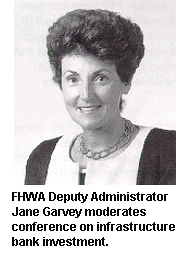 |
| - Cheryle Bailey, (202) 366-6949. | Top |
The effects of paint break down and corrosion on steel bridges are placing an increasing cost burden on bridge maintenance budgets. It is estimated that approximately 40 percent of the Nation's steel bridges are painted with lead-containing paint. Many of these will require some degree of maintenance within the next several years. Increased environmental and worker health and safety regulations regarding maintenance of lead-painted structures have made these maintenance operations significantly more complicated and expensive. Since FHWA's involvement in bridge painting operations did the need to promote expanded with ISTEA, so did the need to promote and implement the best available technology. To maximize the use of existing resources in this technical area, the Special Projects and Engineering Division initiated a cooperative outreach program with FHWA Headquarters, Region, and Division bridge engineering offices. The goal of this program is two fold: (1) create a network of FHWA field engineers and researchers to facilitate two-way information transfer and implementation of research results in the bridge coatings area; and (2) develop technical expertise in this area within FHWA. This will result in a cadre of engineers who can communicate the best technology in support of programs and projects to reduce life-cycle steel bridge corrosion control costs through the selection of regulatory compliant, cost effective coating materials, and maintenance options. |
|
The Bridge Coatings Outreach Program kicked off during the fall with a workshop and the inspection of field exposed coatings by engineers from various FHWA offices. Participants on this team included Ron Andresen and Mark Clabaugh from Central and Eastern Federal Lands Highway Divisions, Joe Huerta from the Office of Engineering Operations and Maintenance, Mike Praul from the New York Division, Larry O'Donnell from the Indiana Division, Carl Highsmith from Region 3, and John Peart, Shuang-Ling Chong, and Bob Kogler from the Office of Engineering R&D Since the initiation of this group in September, team members have participated in various field coating inspections, painting specification reviews, and other research and development efforts. The diverse group has created an efficient conduit for passing information between the field and research communities of FHWA. Similar outreach efforts are planned for other technical areas. |
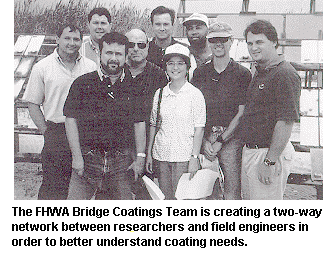 |
| - Shuang-Ling Chong (202) 493-3081, or Bob Kogler, (202) 493-3080. | |
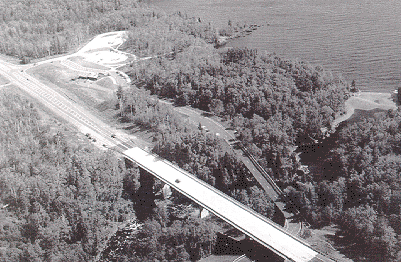
Heated bridge deck technologies (HBT) are moving forward through the Applied Research and Technology Program created by Section 6005 of the Intermodal Surface Transportation Efficiency Act (ISTEA) of 1991. This program aims to identify and promote technologies that will inprove the durability, efficiency, environmental impact, productivity, and safety of highway, transit, and intermodal transportation systems. Heated bridge deck technology is one of the innovative technologies targeted.
The Texas Department of Transportation, one of the States participating in the HBT program, recently awarded a construction contract that includes the first heated bridge deck installation in Texas funded by ISTEA. An innovative anti-glaze heating system is being installed as part of the 15th Avenue bridge rehabilitation project in Amarillo. With this heating system, the thin layerof ice that develops on roadways in freezing temperatures, commonly known as "black ice," is prevented from forming on the bridge surface by circulating propylene glycol, a type of antifreeze, through a series of tubes incorporated into the bridge deck. The propylene glycol is first heated in a geothermal system which includes 100 wells located along the highway. A weather information station with deck sensors monitors air and surface temperatures and moisture levels. When conditions indicate a potential for freezing, the deck sensors trigger the pumps which circulate the propylene glycol through the wells, and the warming process begins. The heating system is not designed to remove large snow accumulations, but it will prevent dangerous thin-sheet ice from forming.
This anti-glaze heating system is part of a project funded under the Highway Bridge Replacement and Rehabilitation Program. A similar system installed in Nebraska used a boiler to heat the propylene glycol, as opposed to the geothermal system used on the 15th Avenue project. The heating system installations on the pedestrian bridge in Lincoln and the 15th Avenue bridge in Amarillo will soon be joined by projects in Virginia, West Virginia, Louisiana, California, and Oregon.
- Steve Emst (202) 366-4619.
Mohamed Salim presented the results of his Graduate Research Fellowship (GRF) study on "The Effects of Exposed Foundations on Bridge Scour" at TFHRC during the fall. He spent approximately a year in the FHWA Hydraulics Laboratory developing a procedure for adapting FHWA's HEC-18 pier scour equation to the common situation of a foundation being located above the stream bed. FHWA has received numerous inquires from States about how to evaluate scour potential for exposed foundation, and this study will answer many of those questions.
Salim also presented his study at a national American Society of Civil Engineers meeting in San Antonio. Following his presentation, Salim received favorable comments from prominent hydraulic engineers.
Hydraulics engineers in the Structures Division think Salim's results are directly applicable to a major North Carolina project at the Oregon Inlet pier. They are currently working with N.C. DOT staff and their consultants to run a brief series of experiments which model one of the Oregon Inlet piers to compare it with Salim's results.
Salim was a graduate student at George Washington University during his GRF assignment. Dr. K. Mahmood was his faculty advisor. Sterling Jones was his FHWA advisor during his assignment at the Hydraulics Laboratory.
- Jon Schans.
The fiber optics system was installed in a model bridge at the structures laboratory of New Mexico State University. It will report out the shrinkage strains in the concrete during the curing process. After the concrete is fully cured, the bridge will be loaded to failure. During this phase, the fiber optics will be used to study the redistribution of forces as the cracking progresses.
These new fiber optic sensors represents significant step in the evolution of embedded sensors for bridges. The objective is to develop a full-scale application to smart bridges. The principal investigator at New Mexico State University for this experiment is Professor Rola Idriss. The project leader for the Naval Research Laboratory is Dr. Alan Kersey.
This is only one application for fiber optics out of several that are being evaluated under the FHWA/Naval Research Laboratory interagency agreement. Other fiber optic uses include measuring the loss of prestress in prestressed concrete girders and measuring deflection of bridges under full load tests. Applications for pavements include vehicle counting, truck weigh in motion, soil mechanics and frost sensing.
- Richard A. Livingston (202) 493-3063.
By using a new video teleconferencing setup, the Priority Technologies Program (PTP) team for FHWA, chaired by King Gee, Deputy Regional Administrator for Region 3, received a real-time update on the PTP by FHWA representatives located in their respective regions. Team members include: John Baxter, Utah Division; Robert Callan, Florida Division; George Ostensen, Michigan Division; Roger Port, Region 7; and John Sweek, Region 6. The role of the PTP team at the onset of the program was to develop first-year guidelines and provide assistance in the development of the program's direction. The PTP team also provides consistency in the basic administration and framework for the program. The PTP is the newest of four elements of the Intermodal Surface Transportation Efficiency Act (ISTEA) Section 6005 program focused on the application and evaluation of new technologies. The 6005 program was created to be the vehicle for a whole new way of delivering innovative technologies. Selected technologies will have a high potential for application and real benefits nationwide. The PTP is one way of implementing Section 6005 so that local level administration can create partnerships between public and private sectors for the leveraging of Federal funds and other cost-sharing initiatives used to implement innovative technologies. |
|
During the video conference session, PTP team members focused on reviewing the first year's operation of the PTP and streamlining the program criteria for upcoming years. Team members discussed the process of selection for first year projects, how the projects measured up to ISTEA Section 6005 criteria, and the development of a more streamlined PTP. An important aspect of the PTP is that FHWA's field offices are provided with significant responsibility and fiscal resources for executing the program, as well as a larger role in setting the direction and administration of the PTP. The field is enthusiastic about its role in developing projects and partnerships. The PTP was established to get new technologies, with national interest, on the ground quickly and applied to solve real problems. Comments and suggestions are welcome. |
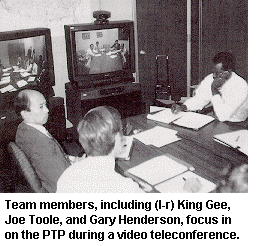 |
| - Richard A. McComb (202) 366-2792. | |
In order to aid the field in selecting projects for the second year of the PTP, team members streamlined the program criteria. Following are the four criteria for selected projects:
Scholar-researcher Randolph Renyu Wu working with the Office of Safety and Traffic Operations R&D Advanced Research Team, recently developed a new robotic trunk design to be used in highway maintenance. The design provides a very good flexible arm which functions somewhat like the body of a snake or an elephant's trunk. This robotic trunk could be mounted on a truck elevator and serve as a platform for a detector or a paint sprayer with shields to protect the environment from being polluted by the lead paint and blast debris. It could remotely inspect bridge paint condition and the physical state of bridge members, recover stripping media and paint with increased efficiency, and reduce the manpower and time required to strip and paint an overpass. The robotic system will be able to work over a bridge or under a bridge for automatic routine inspection and other chores. This system could also be used for underwater inspection of bridges using dive servo-motors as the illustration shows. The robotic trunk is perfectly flexible; it can be bent in such a way that it can even perform manipulations behind an obstacle (obstruction) or in spaces otherwise difficult to reach. The robotic trunk is formed by several elements, each element having a rigid tube inside and supported on the globular hinge of the element below. The rigid tube acts as human bone, and the cables are like human muscles. A special fan-wormwheel mechanism is designed for the trunk unit to pull and loosen cables. This mechanism can reduce the number of motors by one half, ensures the execution of the robotic trunk, and simplifies the control system. The principal advantages of this robotic trunk are perfect flexibility and low cost. |
|
| - James A. Wentworth | Top |
During the fall of 1995, FHWA's Office of Acquisition Management signed a new 5-year cooperative agreement which extends one of the Office of Research and Development's longest partnerships. Since 1965, FHWA, 52 State highway agencies, and two other governmental agencies have jointly financed the basic operations of the AASHTO Materials Reference Laboratory (AMRL). |
|
The AMRL was established to promote adherence to standards in the testing of construction materials, particularly by the State and FHWA laboratories. The AMRL staff inspects laboratories at roughly 24-month intervals -- and regularly distributes proficiency samples -- to assess each laboratory's capabilities for performing standard tests on soils, aggregates, asphalts, and mixtures of these materials. The AMRL also uses the resources of a parallel organization, the Cement and Concrete Reference Laboratory (CCRL), to evaluate laboratory performance on tests on cement and concrete. Results of AMRL assessments provide FHWA with its only independent evaluation of States' (and its own laboratories') testing prowess. FHWA's division offices rely on the results of the AMRL program before approving the expenditure of Federal funds for highway construction. As a side benefit, AMRL evaluations improve the quality of testing for non-Federal construction within each State. With new Federal regulations permitting contractors' test results to be used much more widely in the States' quality assurance decisions, AMRL will need to further expand its programs. The organization's staff, which operates out of laboratory space at the National Institute of Standards and Technology (NIST) in Gaithersburg, Maryland, conducted inspections of 295 laboratories during the most recent 24-month tour and distributed more than 6,000 proficiency samples each year. The AMRL also provides the technical support for the AASHTO Accreditation Program, which has accredited over 200 laboratories across the United States. |
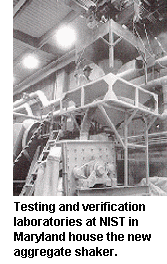 |
| - Terry Mitchell, (202) 493-3147. | |
The AASHTO Materials Research Laboratory conducted inspections of 295 laboratories during the most recent 24-month tour and distributed more than 6,000 proficiency samples each year. |
|
| Top | |
U.S. Department of Transportation
Federal Highway Administration
Research, Development, and Technology
Turner-Fairbank Highway Research Center
6300 Georgetown Pike
McLean, Virginia 22101-2296